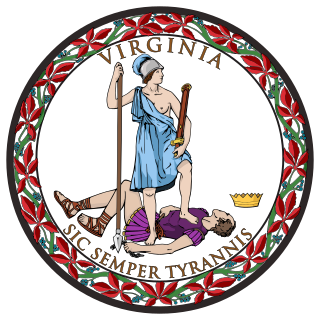
The 1892 United States presidential election was the 27th quadrennial presidential election, held on Tuesday, November 8, 1892. In the fourth rematch in American history, the Democratic nominee, former president Grover Cleveland, defeated the Republican incumbent, President Benjamin Harrison. Cleveland's victory made him the first president in American history to be elected to a non-consecutive second term, a feat that would not be repeated until Donald Trump was elected in 2024. It was also the first of two occasions that incumbents were defeated in consecutive elections—the second being Gerald Ford's loss to Jimmy Carter in 1976, followed by Carter's loss to Ronald Reagan in 1980. To date, it is the only election in which both major party nominees had served as president.

The 1892 United States presidential election in Pennsylvania took place on November 8, 1892, as part of the 1892 United States presidential election. Voters chose 32 representatives, or electors to the Electoral College, who voted for president and vice president.

The 1892 United States presidential election in Montana took place on November 8, 1892, as part of the 1892 United States presidential election. Voters chose three representatives, or electors to the Electoral College, who voted for president and vice president.

The 1892 United States presidential election in New York took place on November 8, 1892. All contemporary 44 states were part of the 1892 United States presidential election. Voters chose 36 electors to the Electoral College, which selected the president and vice president.

The 1892 United States presidential election in Kansas took place on November 8, 1892. All contemporary 44 states were part of the 1892 United States presidential election. Kansas voters chose ten electors to the Electoral College, which selected the president and vice president.

The 1892 United States presidential election in Virginia took place on November 8, 1892, as part of the 1892 United States presidential election. Voters chose 12 representatives, or electors to the Electoral College, who voted for president and vice president.

The 1892 United States presidential election in South Carolina took place on November 8, 1892, as part of the 1892 United States presidential election. Voters chose 9 representatives, or electors to the Electoral College, who voted for president and vice president.

The 1892 United States presidential election in Ohio was held on November 8, 1892. State voters chose 23 electors to the Electoral College, who voted for president and vice president.

The 1892 United States presidential election in Georgia took place on November 8, 1892, as part of the wider United States presidential election. Voters chose 13 representatives, or electors, to the Electoral College, who voted for president and vice president.

The 1892 United States presidential election in Idaho took place on November 8, 1892. All contemporary 44 states were part of the 1892 United States presidential election. State voters chose three electors to the Electoral College, which selected the president and vice president.

The 1892 United States presidential election in Colorado took place on November 8, 1892. All contemporary 44 states were part of the 1892 United States presidential election. Colorado voters chose four electors to the Electoral College, which selected the president and vice president.

The 1892 United States presidential election in Oregon took place on November 8, 1892. All contemporary 44 states were part of the 1892 United States presidential election. State voters chose four electors to the Electoral College, which selected the president and vice president.

The 1892 United States presidential election in South Dakota took place on November 8, 1892. All contemporary 44 states were part of the 1892 United States presidential election. Voters chose four electors to the Electoral College, which selected the president and vice president. South Dakota participated in its first ever presidential election, having been admitted as the 40th state on November 2, 1889.

The 1892 United States presidential election in Nebraska took place on November 8, 1892. All contemporary 44 states were part of the 1892 United States presidential election. Voters chose eight electors to the Electoral College, which selected the president and vice president.

The 1892 United States presidential election in Minnesota took place on November 8, 1892. All contemporary 44 states were part of the 1892 United States presidential election. Minnesota voters chose nine electors to the Electoral College, which selected the president and vice president.

The 1892 United States presidential election in Alabama took place on November 8, 1892. All contemporary 44 states were part of the 1892 United States presidential election. Alabama voters chose eleven electors to the Electoral College, which selected the president and vice president.

The 1892 United States presidential election in Florida took place on November 8, 1892. All contemporary 44 states were part of the 1892 United States presidential election. Florida voters chose four electors to the Electoral College, which selected the president and vice president.

The 1892 United States presidential election in Tennessee took place on November 8, 1892. All contemporary 44 states were part of the 1892 United States presidential election. Tennessee voters chose twelve electors to the Electoral College, which selected the president and vice president.

The 1896 United States presidential election in South Dakota took place on November 3, 1896. All contemporary 45 states were part of the 1896 United States presidential election. Voters chose four electors to the Electoral College, which selected the president and vice president.

The 1896 United States presidential election in North Dakota took place on November 3, 1896. All contemporary 45 states were part of the 1896 United States presidential election. Voters chose three electors to the Electoral College, which selected the president and vice president.

























